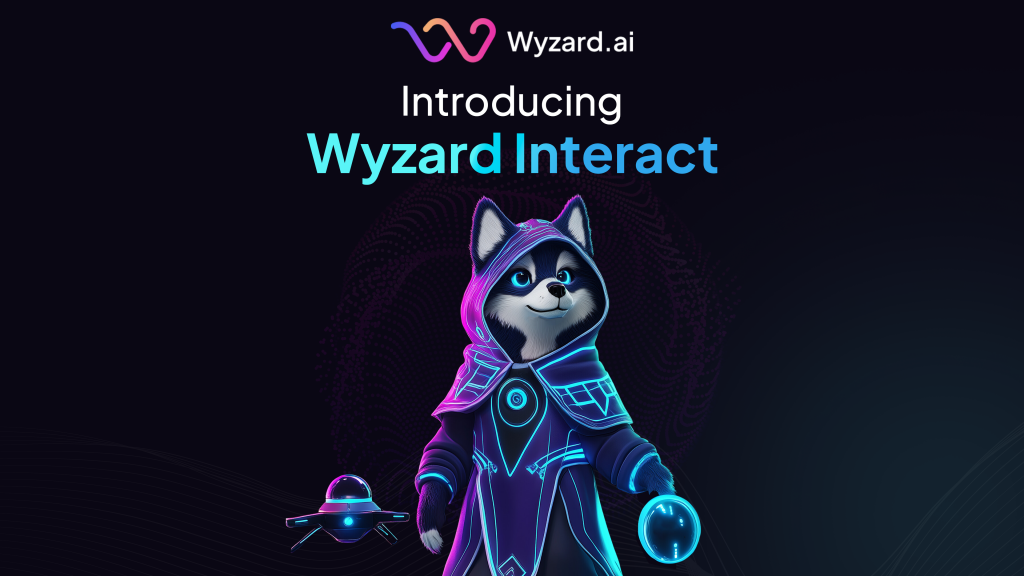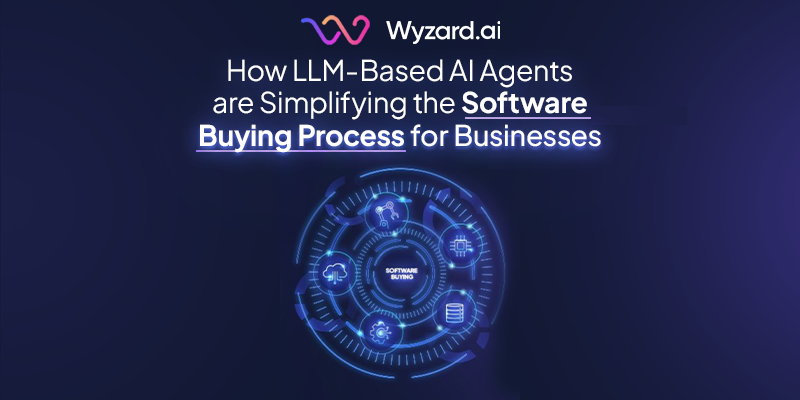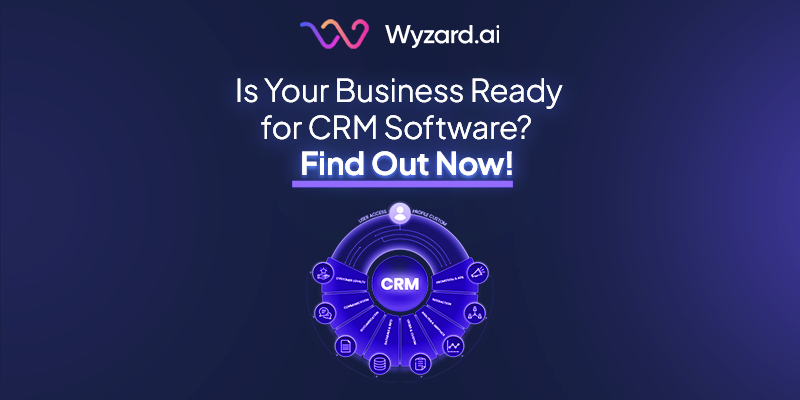Hi, I am Wyzard, your visionary guide in a world where the buying experience is transforming. The way we ...
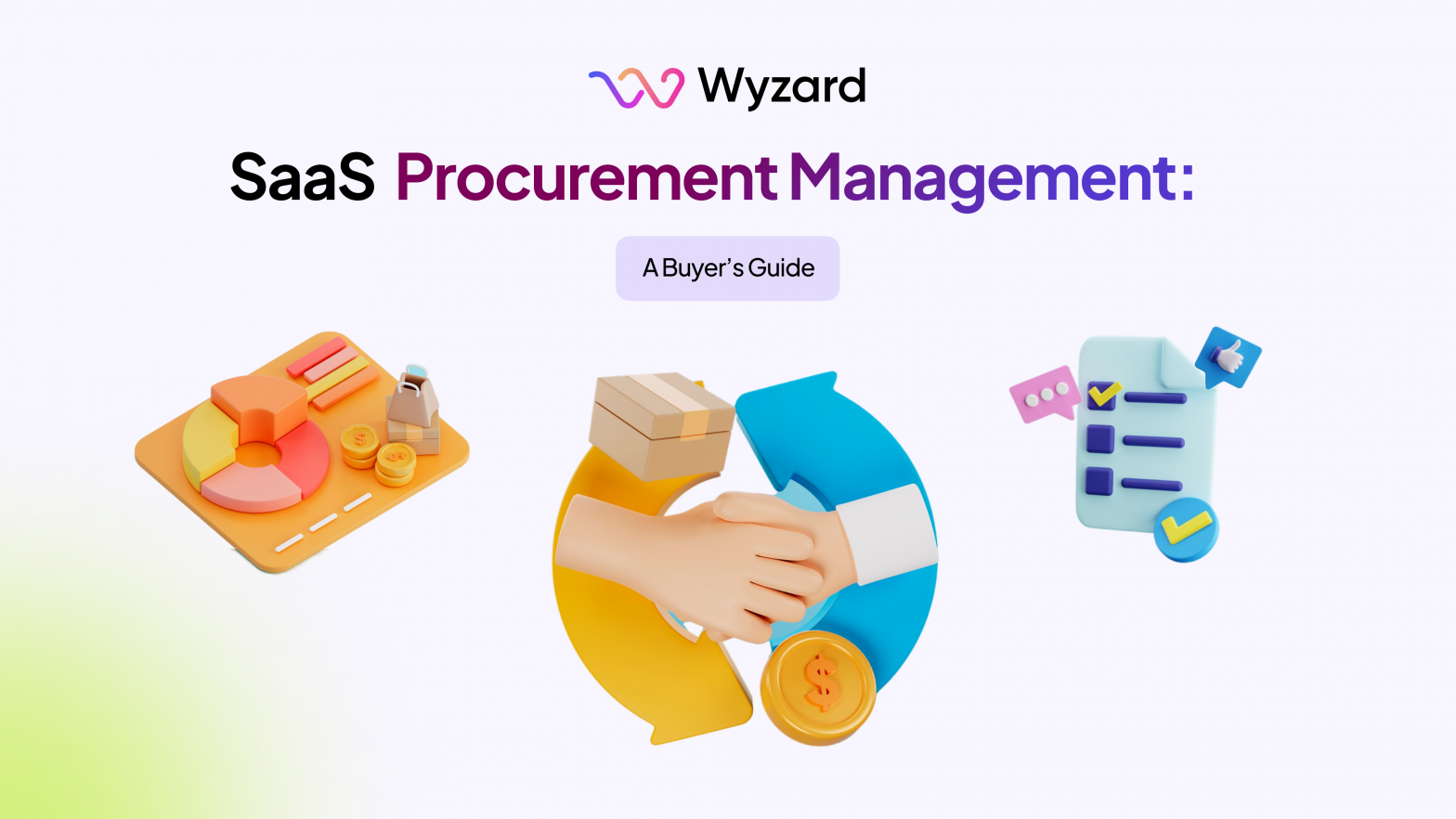
Subscribe Now
With the speed at which AI is being integrated into software, it would be a bad move if businesses decide to run their operations manually. And considering how quick businesses are to adopt new technologies, the rate of SaaS procurement is only going to go higher.
This rapid growth means there will be a lot of options for businesses seeking to leverage SaaS applications. Still, it also brings challenges in terms of selecting the right tools and managing their procurement effectively.
Traditionally, SaaS procurement has been fragmented and inefficient. Different departments within an organization subscribe to various SaaS applications without a centralized approach. This lack of coordination often leads to unnecessary subscriptions.
In this blog, we’ll discuss the importance of SaaS procurement management, the key steps involved in the process, and how a dedicated SaaS procurement platform can simplify and enhance this critical aspect of modern business operations.
But let’s first understand SaaS procurement management!
What is SaaS procurement management?
Most companies don’t have a clear SaaS procurement process in place because they confuse procurement with buying. But SaaS procurement management goes beyond simply buying SaaS applications.
It’s an approach that covers the entire lifecycle of procuring SaaS, from identifying business needs and evaluating vendors to negotiating contracts, managing subscriptions, and ensuring compliance.
While SaaS buying is a one-time transaction focused on acquiring a specific software solution, SaaS procurement management is an ongoing process that requires continuous monitoring. In this process, you have to manage SaaS spend and even set up a clear governance system for your organization’s SaaS portfolio.
A key difference lies in the centralized nature of SaaS procurement management. Rather than allowing individual departments or employees to purchase SaaS applications independently, it establishes a unified framework. This framework’s outcome should help evaluate, procure, and manage SaaS solutions across the entire organization.
This centralization provides you with better visibility, control, and decision-making regarding SaaS investments, ultimately leading to tech cost savings and improved security.
Why is SaaS Procurement Management Needed?
Without a structured approach for SaaS procurement, organizations can face several challenges that can impact their bottom line and expose them to potential risks. Here’s how SaaS procurement management can help you:
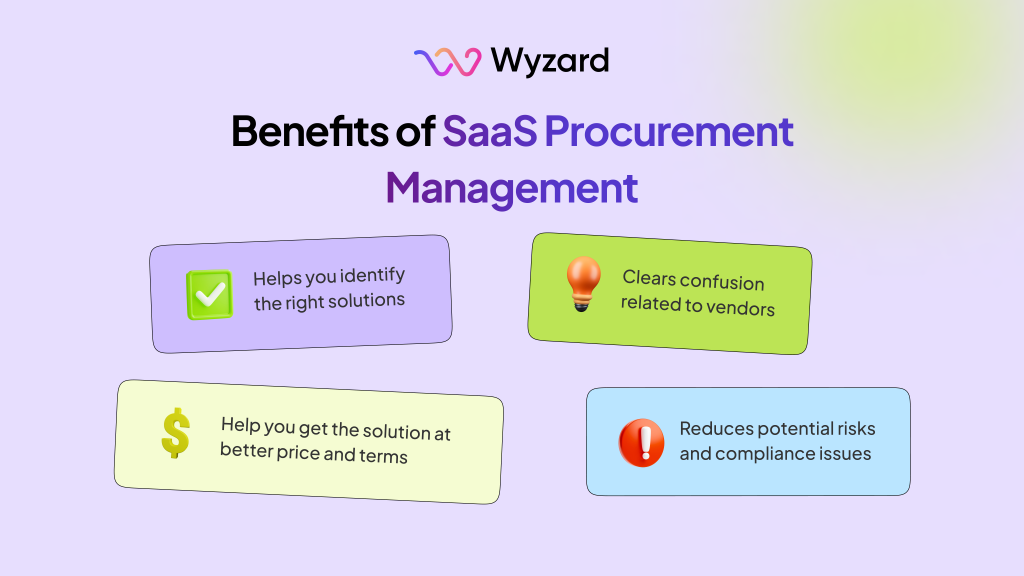
1. Identifying the right solutions
With the proliferation of SaaS offerings, it becomes increasingly challenging to identify the most suitable solutions that align with an organization’s specific requirements.
Effective procurement management enables businesses to thoroughly research and evaluate different SaaS products, their features, and their suitability for the organization’s needs.
This ensures that investments are made in the right tools, maximizing the return on investment (ROI) and preventing unnecessary spending on redundant or ill-fitting solutions.
2. Selecting the ideal vendor
Beyond the software itself, choosing the right vendor is crucial. Procurement management helps in assessing potential vendors’ track records, customer reviews, security and compliance certifications, and support offerings. This ensures you only partner with reliable and reputable SaaS providers.
3. Securing favourable terms and pricing
SaaS vendors often offer varying pricing structures, discounts, and contract terms. Without a structured procurement process, organizations may lack the negotiating power to secure the most favourable deals.
Dedicated SaaS procurement management allows you to leverage your buying power, negotiate better pricing, and secure advantageous terms, such as flexible subscription models, data ownership rights, and termination clauses.
4. Mitigating risks and ensuring compliance
SaaS solutions often handle sensitive data and integrate with critical business systems, making security and compliance essential considerations. Effective procurement management involves evaluating vendors’ security practices, certifications, and adherence to industry regulations. This proactive approach helps organizations mitigate potential risks, such as data breaches or non-compliance penalties, before committing to a SaaS solution.
What is the SaaS Procurement Management Process?
When your approach to SaaS procurement is structured, the whole process of procuring and onboarding a solution becomes smooth. Let’s dive into the key steps involved in the SaaS procurement management process:
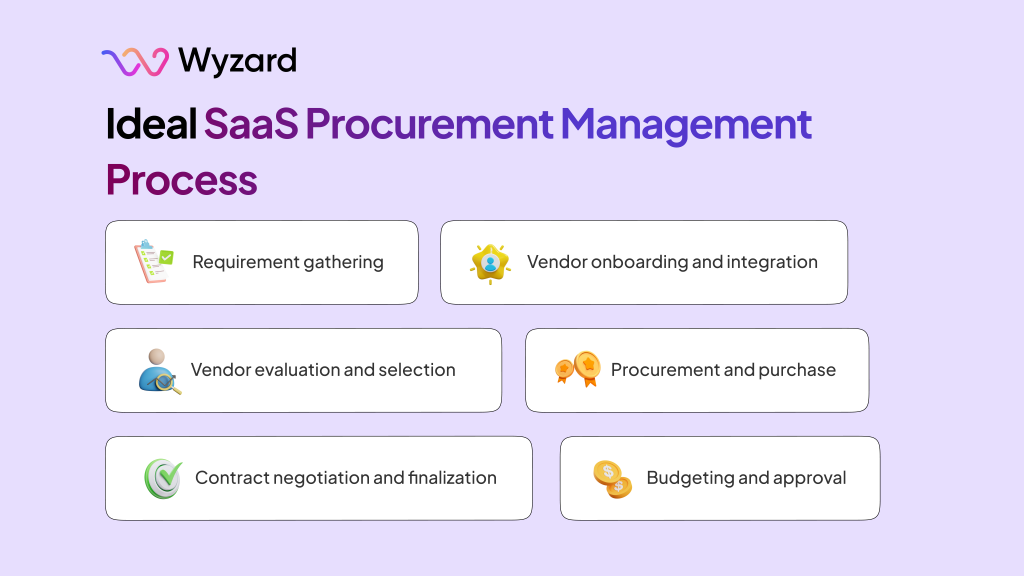
1. Requirement gathering
The procurement journey begins with a thorough understanding of what software solutions your business actually needs.
In this step, you would collaborate with various stakeholders, including end-users, IT teams, and business units, to identify the specific requirements for the desired SaaS solution.
It’s crucial to gather insights on the features, functionalities, integrations, and scalability required to support the organization’s objectives. For example, if you’re procuring a project management tool, you might need to consider factors like collaborative capabilities, task tracking, resource allocation, and reporting functionalities.
2. Budgeting and approval
Once the requirements are clearly defined, the next step is to allocate a budget for the SaaS procurement. This involves a thorough assessment of your financial constraints and the potential return on investment (ROI) of the desired SaaS solution.
It’s essential to consider not only the initial subscription costs but also any potential implementation, training, and ongoing maintenance expenses.
Collaborating with finance teams and key stakeholders is crucial during this stage to ensure alignment on the budgetary allocations. To maximise their investment, you might need to prioritize their requirements and explore cost-effective options, such as bundled pricing or volume discounts.
Moreover, securing the necessary approvals from decision-makers is a critical step in the budgeting process. This may involve presenting a detailed business case that outlines the expected benefits, costs, and risks associated with the SaaS procurement. Obtaining buy-in from leadership and relevant committees ensures that the procurement process proceeds smoothly and aligns with the organization’s strategic objectives.
3. Vendor evaluation and selection
With the requirements and budget in place, it’s time to evaluate potential SaaS vendors. In this process, you’ll be researching and shortlisting vendors that align with your needs, assessing their track record, customer reviews, and security and compliance certifications.
It’s also advisable to request product demonstrations or trials to gain hands-on experience with the software and validate its suitability.
Let’s say you’re procuring a customer relationship management (CRM) solution like HubSpot or Salesforce, you might have to evaluate factors like ease of use, customization options, integration capabilities with existing systems, and the vendor’s support and training offerings.
But first, identifying the right CRMs and then comparing them to find the one is a task that demands a lot of time. But this is only for CRM. Imagine doing this across categories like design, project management, communication, marketing analytics, etc. In short, it’s a tall order.
And this is where Wyzard’s comes in with its SaaS Discovery feature. It gives AI-based insights regarding SaaS solutions that best fit your needs and budget. We’ll discuss more about it later in the blog.
4. Contract Negotiation and Finalization
Once the preferred vendor is selected, the next step is to negotiate the contract terms. This is a critical phase where procurement professionals can leverage their expertise to secure favourable pricing, Service Level Agreements (SLAs), data ownership rights, and termination clauses. It’s also essential to review the vendor’s privacy and security policies to ensure compliance with industry regulations and organizational standards.
But again, if you have an end-to-end SaaS procurement management solution like Wyzard, you don’t need a procurement team to negotiate contracts. Wyzard helps you optimize your SaaS procurement process through data-driven negotiations.
During this stage, it’s crucial to involve legal and IT teams to review the contract thoroughly and ensure that it aligns with the organization’s interests and mitigates potential risks.
5. Procurement and Purchase
With the contract finalized, the procurement team can proceed with the actual purchase of the SaaS solution. This step involves things like issuing a purchase order, processing payments, and coordinating with the vendor for access provisioning and account setup.
6. Vendor Onboarding and Integration
The final step in the SaaS procurement process is vendor onboarding and integration. This involves working closely with the vendor to ensure a smooth implementation and integration of the SaaS solution into the organization’s existing IT infrastructure and workflows.
Depending on the complexity of the solution, this phase may involve activities such as data migration, user training, and customization to align with the organization’s specific processes. It’s essential to establish clear communication channels and assign dedicated resources to oversee the onboarding process and ensure the successful adoption of the SaaS solution.
How a SaaS Procurement Platform Can Help
Dealing with the SaaS procurement management process can be a challenging task, especially for organizations with a growing SaaS portfolio. A dedicated SaaS procurement platform like Wyzard can streamline and simplify this process for you.
Here are some of the benefits of using Wyzard for your SaaS procurement needs:
- Save time with comprehensive research: A SaaS procurement platform like Wyzard offers a centralized marketplace with a vast assortment of SaaS products, consolidating research and pricing information. This saves valuable time and effort in identifying the best-fit solutions for your organization’s needs.
- Negotiation advisory: With extensive vendor intelligence, pricing benchmarks, and user reviews, a platform like Wyzard can provide strategic procurement and negotiation advisory services. This ensures you secure the most competitive pricing and favourable contract terms.
- Quicker onboarding and integration: A SaaS procurement platform can facilitate seamless onboarding and integration of the procured solutions with your existing IT infrastructure and workflows, ensuring a smooth adoption process.
- Security and compliance alerts: Advanced platforms offer proactive alerts and risk assessments, helping you identify potential security or compliance issues before procurement.
- Centralized contract management: A dedicated contract vault feature allows you to centralize and safeguard your software agreements, ensuring efficient organization and easy retrieval of terms, clauses, and conditions. This feature helps manage your SaaS after you procure it.
Wyzard, a comprehensive AI-powered SaaS procurement platform, offers all these capabilities and more. With its AI-driven discovery, robust budgeting and forecasting tools, and deep vendor integrations, it ensures you optimize your SaaS investments from procurement to deployment.
Take control of your SaaS procurement process and maximize the value of your software stack. Book a demo with Wyzard today!
Other blogs
The latest industry news, interviews, technologies, and resources.
March 17, 2025
How LLM-Based AI Agents are Simplifying the Software Buying Process for Businesses
Let’s talk about something that’s becoming a game-changer in our daily lives: AI agents. Think of them as your ...

March 11, 2025
Is Your Business Ready for CRM Software? Find Out Now!
Running a small business can feel like juggling a million things at once. You are busy with customers, ensuring ...

Subscribe
Today!
Error: Contact form not found.
Subscribe to learn about new product features, the latest in technology, solutions, and updates.
 Meet Us at
Meet Us at 
